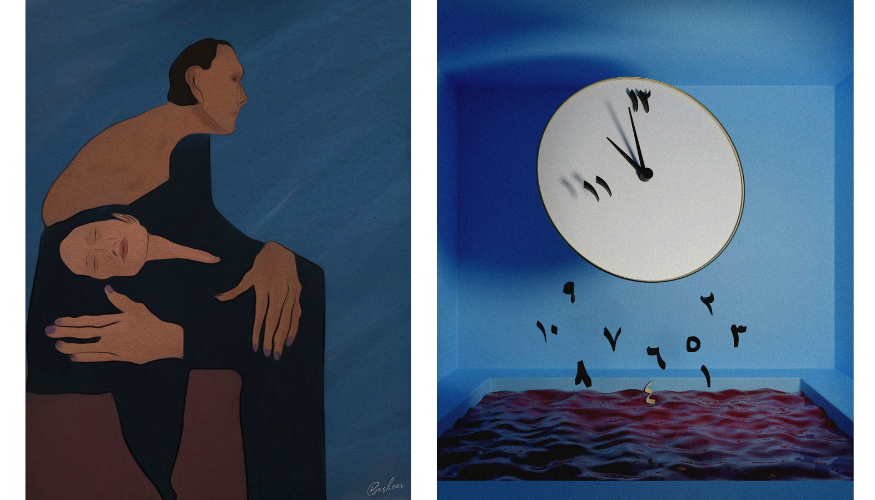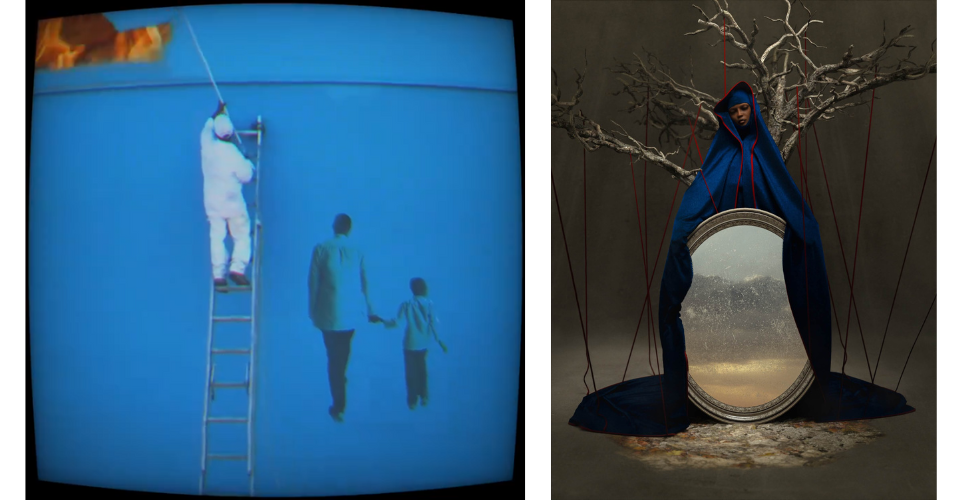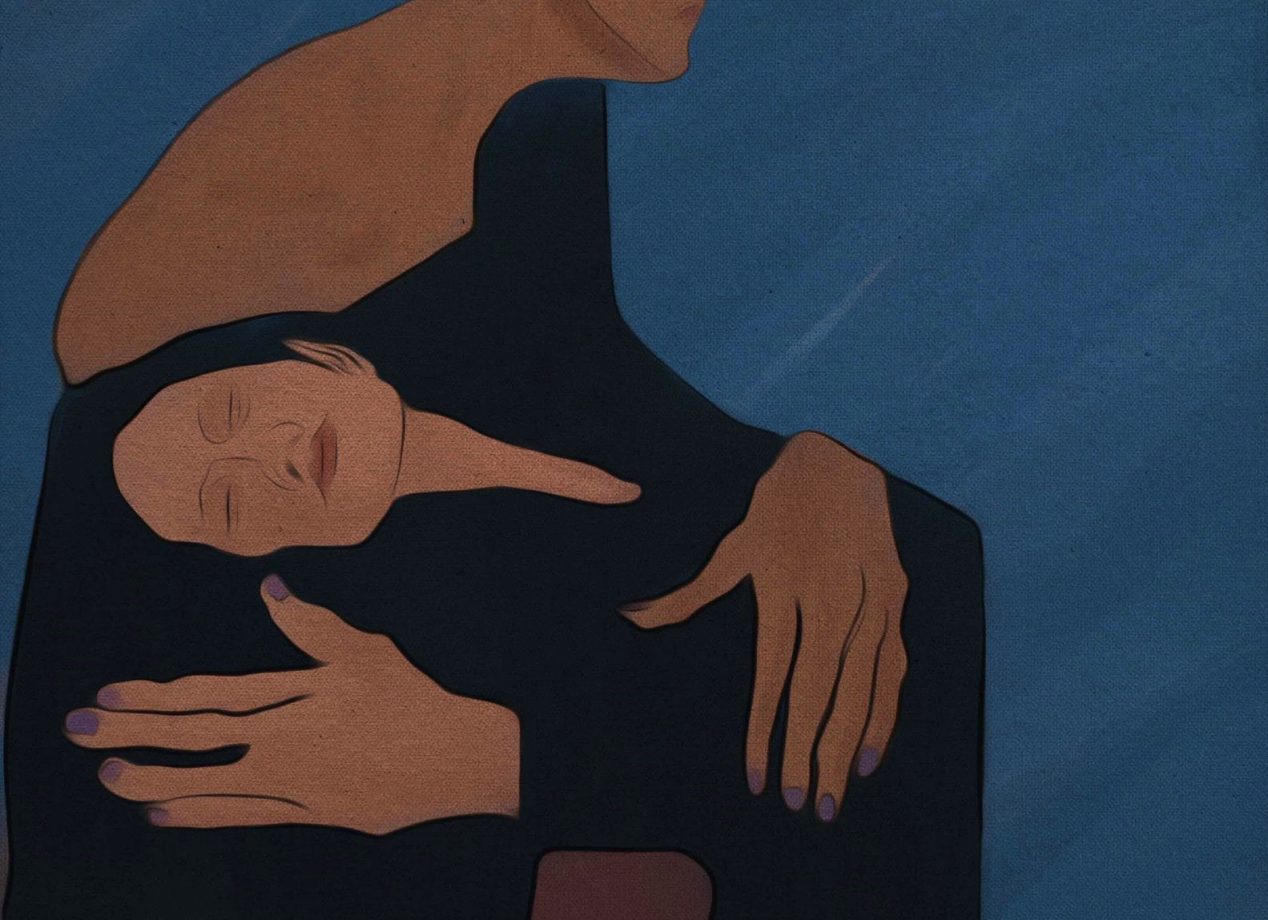Art 4 Sudan is a fundraising initiative that brings together artists from around the world, harnessing emerging technology to create new work in solidarity with Sudan. The works are permanently documented on the Solana blockchain and showcased on Exchange Art. Sotheby's Institute faculty and studio director, Leo Crane, reflects on the initiative and a recent panel discussion.
A figure rests her head in a black-draped lap, eyes closed. Her companion sits, detached, gazing into a bright blue sky. This is Love and Depression (below, left) by Basheer Ahmed, one of many paintings abandoned in his gallery in Khartoum at the outbreak of war almost one year ago. Latest reports indicate that the gallery has been looted and burned.
Basheer, also known as Azad, is a Sudanese painter and writer, who recently joined Art 4 Sudan, a blockchain-driven campaign in solidarity with Sudan, where over 8.1 million people have been displaced by the ongoing war. Last week, he called in from his home country to discuss the campaign on a panel hosted by Sotheby’s Institute of Art.
“After the war, I had zero capacity to create art,” Basheer said, “The person who used to paint, who used to write, was dead. When I saw the campaign, I decided to get back into it. I decided to participate, even though my experience with web3 and blockchain was very limited. Through art and through my personal involvement, I saw this was the perfect opportunity for me to help my country.”

Basheer had been inspired by Rayan Elnayal (above, right), a Sudanese artist and educator based in London. Facing international apathy to the brutal war, Rayan turned to her online community to take action. With a core group of organisers, she convened 28 artists from around the world, including Basheer, to create an exhibition on the blockchain as a permanent record of the crisis.
On 22 March, Art 4 Sudan was launched in partnership with digital art platform Exchange Art. Artists minted their digital or digitised work on the Solana blockchain to create a non-fungible token (NFT). These have been listed for sale in the cryptocurrency SOL, curated into an online exhibition and promoted to a global network of cryptoart collectors. With no overheads or fees, one hundred percent of funds are directed to humanitarian initiatives in Sudan.
Rayan says: “Art 4 Sudan gathers artists who understand the power of unity, the importance of solidarity, and how art and technology can, and should contribute to humanitarian causes."
The campaign builds on a number of grass-roots art initiatives that have mobilised the speed, transparency and reach of blockchain for rapid response impact. These campaigns have convened thousands of artists raising hundreds of thousands of dollars after floods in Pakistan, protests in Iran, the Turkey/Syria earthquake, wars in Ukraine and Gaza, and other causes. Art for Humanity was one such campaign launched in November in solidarity with Palestinian civilians. Organiser Faraz Ghorbanpour describes how this experience shaped his contribution to Art 4 Sudan: “When I was working on Art for Humanity, I was really seeing a global connection. Because of our global scale in creating art, there is also a global scale in collecting art. We bridge so many different linguistic barriers, time barriers. And if we are to make these humanitarian changes, it needs to involve all of humanity, not just a timezone of it. That was the greatest lesson I learnt from how to use the blockchain which I really hope I carried on into Art 4 Sudan.”
The Art 4 Sudan exhibition reflects this global perspective with an eclectic variety of artworks from artists across the world. All the works are united by the inclusion of blue as a reference to #BlueforSudan, the social media campaign honouring Mohamed Mattar and the 112 peaceful protestors killed in the 2019 Khartoum massacre.
Some artworks are about the immediacy of the war, such as Mohammed Dafalla Mahgoub’s War in Sudan, which reveals different aspects of the conflict when viewed in red, green or blue light. Others reflect on the long view of Sudanese heritage, such as The Afternoon Spring Collapsed by Dania Abdalla (also known as Destructionella).
“I wanted to pay homage to these small but beautiful cherished cultural moments that make us Sudanese people,” says Dania, ”the iconic singer Mohammed Wardi; the magazines with random covers that would say something like ‘Does the air hostess ever get married?’. I wanted to depict the mosaic of who we are, the little things that we love and appreciate to the very real atrocities of war that are depicted by that blue.”
Other works demonstrate how creativity and emerging technologies can interpret and process the impact of war, including generative AI by Pierandrea Micale (aka Odyssey of the Heart), pixel animation by Nygilia, digital fashion editorial by Leonel Piccardo (aka Glitchofmind) (below, right), and blockchain poetry by Ibraheem Leone (below, left).

At the time of writing, 34 works have been collected by seasoned cryptoart enthusiasts as well as those new to blockchain. Further crypto-donations have been made directly to the project wallet. Last week, the first round of funding was transferred to Sudanese American Physicians Association, Darfur Women Action Group, and to three community fundraisers directly supporting displaced families in urgent need. Full details can be found here, including direct links to support.
As more works are sold, more funds will be transferred to support Sudanese civilians affected by the war. Beyond that, the campaign is encouraging a wide and diverse audience to dwell on the reality of the war in Sudan on a human level. The emotive interpretations in the artworks and the personal testimonies such as Basheer’s take us deeper than scant headlines. Looking further ahead, we can rely on the permanence and transparency of blockchain to preserve Art 4 Sudan as a record of artists and collectors coming together in solidarity at a time of crisis.
View and collect artworks from the Art for Sudan exhibition here.
